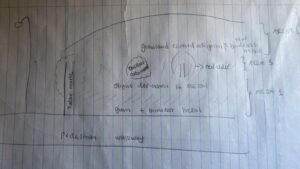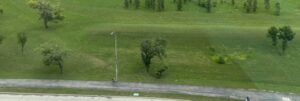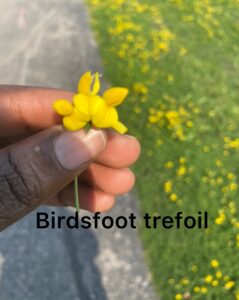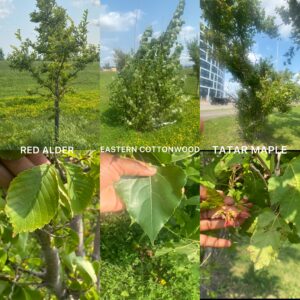I plan to study the plants (trees, shrubs, grass and flowers).
I examined 3 different areas of the land and noticed the following:
In Area 1, there are mainly grasses, lots of birdsfoot trefoil flowers, a few Tatar maple trees planted in a straight line closest to the pedestrian walkway, the land surface is sunken after where the trees are located. Tatar maple (Acer tataricum) tree has red flowers all over and is the only tree on this grassland that has flowers.
In Area 2, the land is hilly/elevated , mainly grasses present, hardly any birdsfoot trefoil flowers (patchy distribution), no trees here. This makes me wonder if there is some form of machinery (eg: pipes below, I’m just speculating I’m not sure but it is most likely because of how close it is to school buildings and this is the only elevated ground on the whole site I am observing ).
In Area 3: the area is covered with grasses and birdsfoot trefoil in almost equal amounts, there are also few trees of only 2 kinds, the Eastern cottonwood tree and the Red alder tree. I didn’t notice any flowers on them but they look young so maybe some will develop as they grow.
My hypothesis is that “the weather affects the growth/flourishing rate of plants”
My prediction is that when the weather changes from warm and sunny to cold and snowy (winter), the plants will not flourish, the birdsfoot trefoil flowers will have withered away before all the grasses fully turn brown and die off. The red flowers of the Tatar maple tree will darken, turn brown before it withers away as the leaves of the tree falls. The leaves of the Eastern cottonwood and Red alder trees will also turn brown and eventually wither.
Response variable: colour of leaves (continuous because it can either be green or various discolouration (eg: spotty) before it gets fully brown and falls off)
Another response variable can be leaf location (categorical because it can either be on the tree or fallen off)
Explanatory variable: the weather (continuous because the change in temperature is not discrete)




Blog Post 5 Part 2: Feedback on your blog post
I like your hypothesis, it is simple and with the variation in flora you have to observe for growth rate within your chosen location, your data will likely be quite insightful.
Your predictions do seem consistent with the hypothesis. I do notice that the growth rates across each flora species will vary based on multiple factors other than the weather, ie. pests and human activity if any of the flora is disrupted in growth due to people touching or stepping on the areas you are researching in.
Overall, your variables seem easy to measure, the other concern to remember is that the weather may not change as much until the end of the season, only once there is more variation could the changes you are predicting be more apparent.